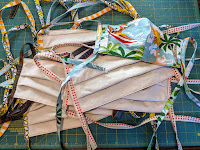"There are many kinds of selfishness in this world, but the most selfish is hoarding time,
because none of us know how much we have,
and it is an affront to God to assume there will be more."
~Mitch Alborn in Finding Chika
Masks
We are all doing what we can to fight this virus - the bravest on the front lines, the rest of us donating to charities, tipping delivery people heavily, and staying home. |
| Homemade masks |
 |
| Reinforce corners by backstitching |
Delivery drivers, grocers, homeless shelters, rehab centers, nursing homes, and vet clinics are among the people and places that can use these to free up professional masks for our front line heroes. Mine went to a collection center for distribution.
Tip: Instead of adding four ties, make two longer ties {16" for each tie end plus the width of the short end} and zigzag them so they can better take the stress of tying. Also backstitch at mask corners to reinforce those points of stress.
Cooking
 |
| Making chicken broth with vegetable peelings |
Quilting
The addition of pink gives these trees the glow of spring... even though the greens lean to the yellow side. {In my mind, that usually indicates fall.} |
| Springtime tree blocks laid out with with pink and green |
With spring in mind, an apple tree seemed in order. Lovely red and white plaid paired with red polka dots and a large circular print indicative of green apples. My mistake was adding those active prints to the light side of the trees. Instead of a tree, it's simply a mess.
 |
| First attempt at apple tree quilt block |
I laid out a new one with only polka dots and whites on the light side. It's the right-hand one on the bottom row. The circles and plaids now sit with the green - where their values match. As you can see, this arrangement works much better.
 |
| Spring tree blocks sewn |
And no, I didn't unsew the first tree. These triangles are too small and fiddly. I just tossed it... into the scrap bag. It's a learning experience.
 I also finished two more tote bags. There wasn't quite enough fabric for one on the left but I made it anyway. It will just be a grocery tote; too small for a foster child. {It was already cut when I switched to mask making.}
I also finished two more tote bags. There wasn't quite enough fabric for one on the left but I made it anyway. It will just be a grocery tote; too small for a foster child. {It was already cut when I switched to mask making.}Reading
 Psychologist Mary Pipher wrote Reviving Ophelia about the needs of adolescent girls and now has written this one about cultural and developmental issues women face as they age. In some ways it reminds me of Atul Gawande's Being Mortal and in fact, she references his book and several of the same research projects. Atul's book addresses end-of-life issues while this one focuses on how women age.
Psychologist Mary Pipher wrote Reviving Ophelia about the needs of adolescent girls and now has written this one about cultural and developmental issues women face as they age. In some ways it reminds me of Atul Gawande's Being Mortal and in fact, she references his book and several of the same research projects. Atul's book addresses end-of-life issues while this one focuses on how women age.FUR
One finished quilt, eight totes that took 11.5 yards, plus 8.5 yards for masks makes 27 yards this month. YTD = 47.5 yards.
Please stay safe.
Enjoy the day, Ann